CJ-2130 Criminal Law: R. v. Mellor Case Analysis Report - March 2019
VerifiedAdded on 2023/04/17
|12
|3163
|359
Report
AI Summary
This report presents a comprehensive analysis of the R. v. Mellor 2018 MBQB 61 case using the FIRAC method. The report begins with the facts of the case, detailing the accusation of sexual assault and the defendant's defenses, including consent and mistaken belief in consent. It identifies the key legal issues, such as consent and the reliability of witness testimony, and explores the relevant rules, including the principles established in R. v. Ewanchuk and R. v. Menow. The application section analyzes the judge's reasoning, particularly regarding the credibility of witnesses and the evaluation of evidence. The report also addresses the complainant's delayed disclosure of the assault and the judge's approach to this evidence. The conclusion summarizes the court's findings and the implications of the case, emphasizing the importance of consent in sexual assault cases and the evaluation of evidence in criminal law.
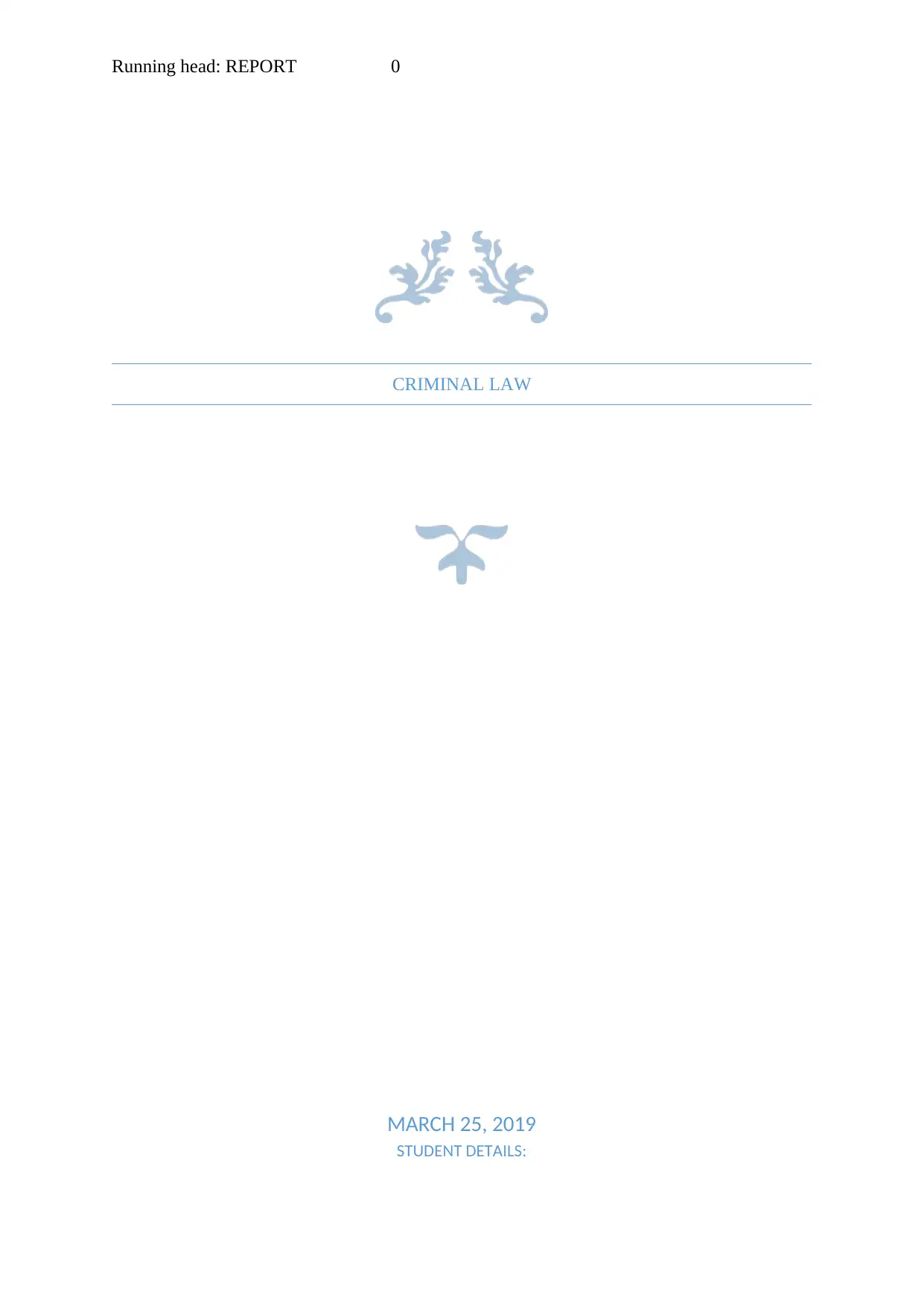
Running head: REPORT 0
CRIMINAL LAW
MARCH 25, 2019
STUDENT DETAILS:
CRIMINAL LAW
MARCH 25, 2019
STUDENT DETAILS:
Paraphrase This Document
Need a fresh take? Get an instant paraphrase of this document with our AI Paraphraser
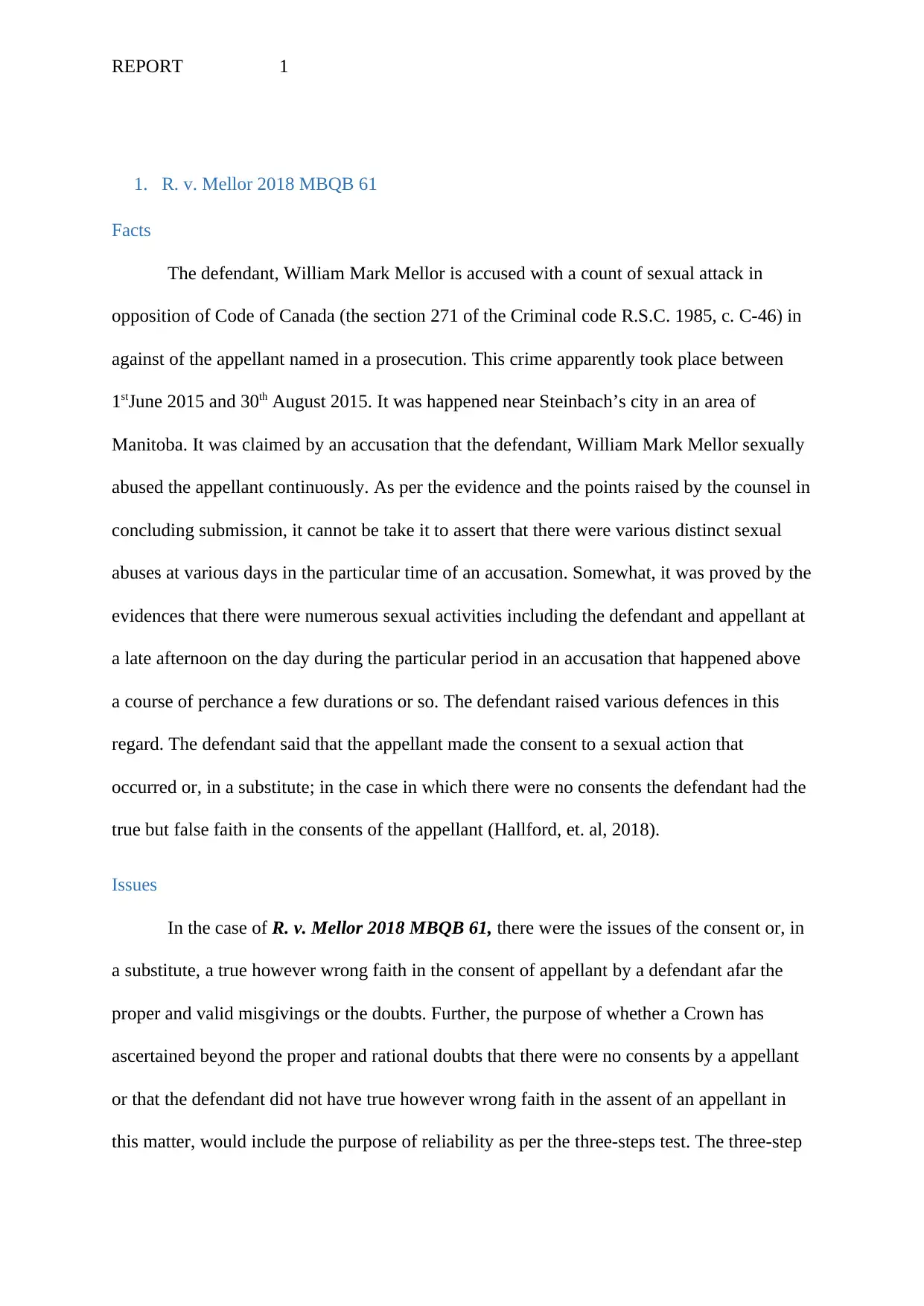
REPORT 1
1. R. v. Mellor 2018 MBQB 61
Facts
The defendant, William Mark Mellor is accused with a count of sexual attack in
opposition of Code of Canada (the section 271 of the Criminal code R.S.C. 1985, c. C-46) in
against of the appellant named in a prosecution. This crime apparently took place between
1stJune 2015 and 30th August 2015. It was happened near Steinbach’s city in an area of
Manitoba. It was claimed by an accusation that the defendant, William Mark Mellor sexually
abused the appellant continuously. As per the evidence and the points raised by the counsel in
concluding submission, it cannot be take it to assert that there were various distinct sexual
abuses at various days in the particular time of an accusation. Somewhat, it was proved by the
evidences that there were numerous sexual activities including the defendant and appellant at
a late afternoon on the day during the particular period in an accusation that happened above
a course of perchance a few durations or so. The defendant raised various defences in this
regard. The defendant said that the appellant made the consent to a sexual action that
occurred or, in a substitute; in the case in which there were no consents the defendant had the
true but false faith in the consents of the appellant (Hallford, et. al, 2018).
Issues
In the case of R. v. Mellor 2018 MBQB 61, there were the issues of the consent or, in
a substitute, a true however wrong faith in the consent of appellant by a defendant afar the
proper and valid misgivings or the doubts. Further, the purpose of whether a Crown has
ascertained beyond the proper and rational doubts that there were no consents by a appellant
or that the defendant did not have true however wrong faith in the assent of an appellant in
this matter, would include the purpose of reliability as per the three-steps test. The three-step
1. R. v. Mellor 2018 MBQB 61
Facts
The defendant, William Mark Mellor is accused with a count of sexual attack in
opposition of Code of Canada (the section 271 of the Criminal code R.S.C. 1985, c. C-46) in
against of the appellant named in a prosecution. This crime apparently took place between
1stJune 2015 and 30th August 2015. It was happened near Steinbach’s city in an area of
Manitoba. It was claimed by an accusation that the defendant, William Mark Mellor sexually
abused the appellant continuously. As per the evidence and the points raised by the counsel in
concluding submission, it cannot be take it to assert that there were various distinct sexual
abuses at various days in the particular time of an accusation. Somewhat, it was proved by the
evidences that there were numerous sexual activities including the defendant and appellant at
a late afternoon on the day during the particular period in an accusation that happened above
a course of perchance a few durations or so. The defendant raised various defences in this
regard. The defendant said that the appellant made the consent to a sexual action that
occurred or, in a substitute; in the case in which there were no consents the defendant had the
true but false faith in the consents of the appellant (Hallford, et. al, 2018).
Issues
In the case of R. v. Mellor 2018 MBQB 61, there were the issues of the consent or, in
a substitute, a true however wrong faith in the consent of appellant by a defendant afar the
proper and valid misgivings or the doubts. Further, the purpose of whether a Crown has
ascertained beyond the proper and rational doubts that there were no consents by a appellant
or that the defendant did not have true however wrong faith in the assent of an appellant in
this matter, would include the purpose of reliability as per the three-steps test. The three-step
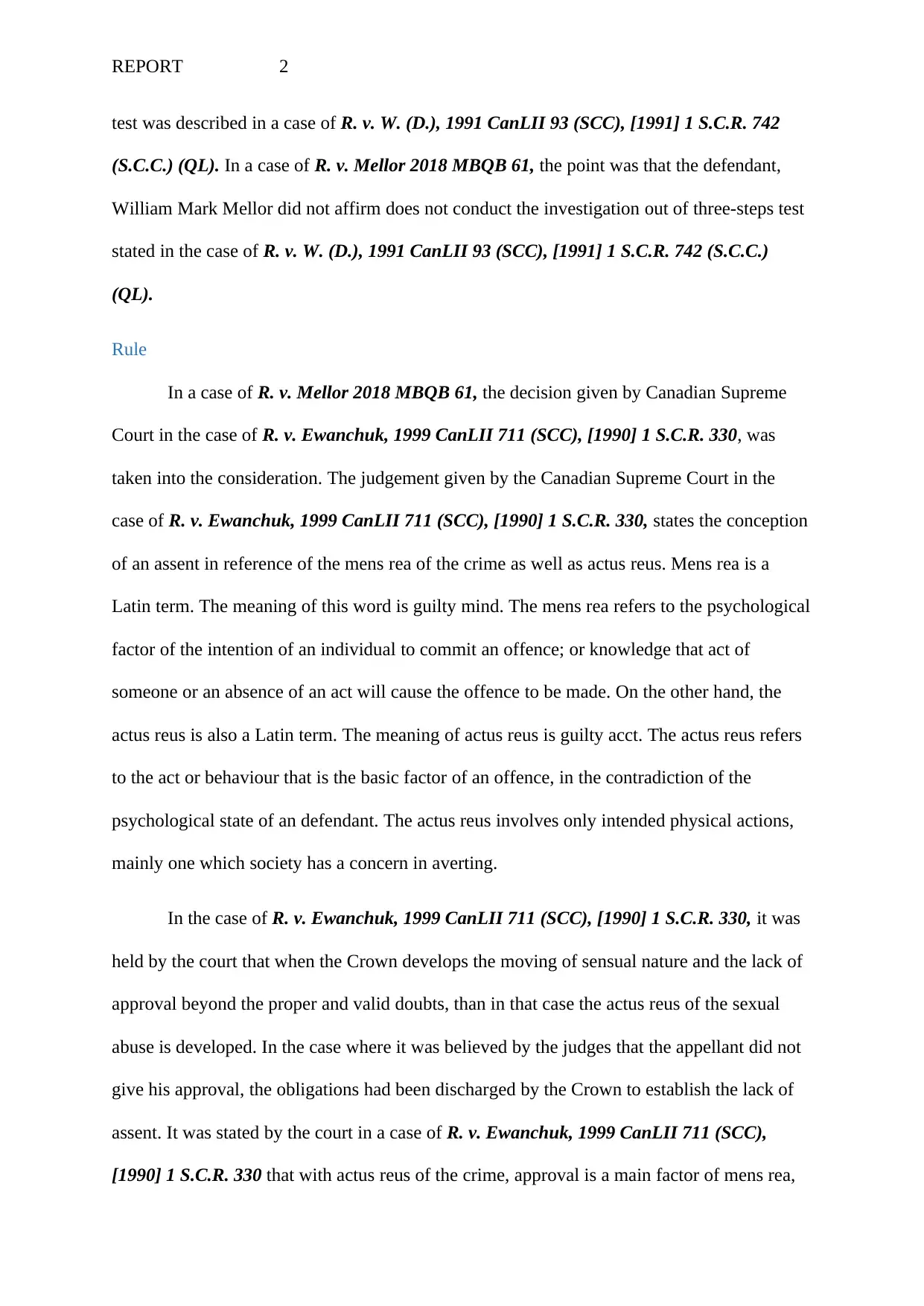
REPORT 2
test was described in a case of R. v. W. (D.), 1991 CanLII 93 (SCC), [1991] 1 S.C.R. 742
(S.C.C.) (QL). In a case of R. v. Mellor 2018 MBQB 61, the point was that the defendant,
William Mark Mellor did not affirm does not conduct the investigation out of three-steps test
stated in the case of R. v. W. (D.), 1991 CanLII 93 (SCC), [1991] 1 S.C.R. 742 (S.C.C.)
(QL).
Rule
In a case of R. v. Mellor 2018 MBQB 61, the decision given by Canadian Supreme
Court in the case of R. v. Ewanchuk, 1999 CanLII 711 (SCC), [1990] 1 S.C.R. 330, was
taken into the consideration. The judgement given by the Canadian Supreme Court in the
case of R. v. Ewanchuk, 1999 CanLII 711 (SCC), [1990] 1 S.C.R. 330, states the conception
of an assent in reference of the mens rea of the crime as well as actus reus. Mens rea is a
Latin term. The meaning of this word is guilty mind. The mens rea refers to the psychological
factor of the intention of an individual to commit an offence; or knowledge that act of
someone or an absence of an act will cause the offence to be made. On the other hand, the
actus reus is also a Latin term. The meaning of actus reus is guilty acct. The actus reus refers
to the act or behaviour that is the basic factor of an offence, in the contradiction of the
psychological state of an defendant. The actus reus involves only intended physical actions,
mainly one which society has a concern in averting.
In the case of R. v. Ewanchuk, 1999 CanLII 711 (SCC), [1990] 1 S.C.R. 330, it was
held by the court that when the Crown develops the moving of sensual nature and the lack of
approval beyond the proper and valid doubts, than in that case the actus reus of the sexual
abuse is developed. In the case where it was believed by the judges that the appellant did not
give his approval, the obligations had been discharged by the Crown to establish the lack of
assent. It was stated by the court in a case of R. v. Ewanchuk, 1999 CanLII 711 (SCC),
[1990] 1 S.C.R. 330 that with actus reus of the crime, approval is a main factor of mens rea,
test was described in a case of R. v. W. (D.), 1991 CanLII 93 (SCC), [1991] 1 S.C.R. 742
(S.C.C.) (QL). In a case of R. v. Mellor 2018 MBQB 61, the point was that the defendant,
William Mark Mellor did not affirm does not conduct the investigation out of three-steps test
stated in the case of R. v. W. (D.), 1991 CanLII 93 (SCC), [1991] 1 S.C.R. 742 (S.C.C.)
(QL).
Rule
In a case of R. v. Mellor 2018 MBQB 61, the decision given by Canadian Supreme
Court in the case of R. v. Ewanchuk, 1999 CanLII 711 (SCC), [1990] 1 S.C.R. 330, was
taken into the consideration. The judgement given by the Canadian Supreme Court in the
case of R. v. Ewanchuk, 1999 CanLII 711 (SCC), [1990] 1 S.C.R. 330, states the conception
of an assent in reference of the mens rea of the crime as well as actus reus. Mens rea is a
Latin term. The meaning of this word is guilty mind. The mens rea refers to the psychological
factor of the intention of an individual to commit an offence; or knowledge that act of
someone or an absence of an act will cause the offence to be made. On the other hand, the
actus reus is also a Latin term. The meaning of actus reus is guilty acct. The actus reus refers
to the act or behaviour that is the basic factor of an offence, in the contradiction of the
psychological state of an defendant. The actus reus involves only intended physical actions,
mainly one which society has a concern in averting.
In the case of R. v. Ewanchuk, 1999 CanLII 711 (SCC), [1990] 1 S.C.R. 330, it was
held by the court that when the Crown develops the moving of sensual nature and the lack of
approval beyond the proper and valid doubts, than in that case the actus reus of the sexual
abuse is developed. In the case where it was believed by the judges that the appellant did not
give his approval, the obligations had been discharged by the Crown to establish the lack of
assent. It was stated by the court in a case of R. v. Ewanchuk, 1999 CanLII 711 (SCC),
[1990] 1 S.C.R. 330 that with actus reus of the crime, approval is a main factor of mens rea,
⊘ This is a preview!⊘
Do you want full access?
Subscribe today to unlock all pages.

Trusted by 1+ million students worldwide
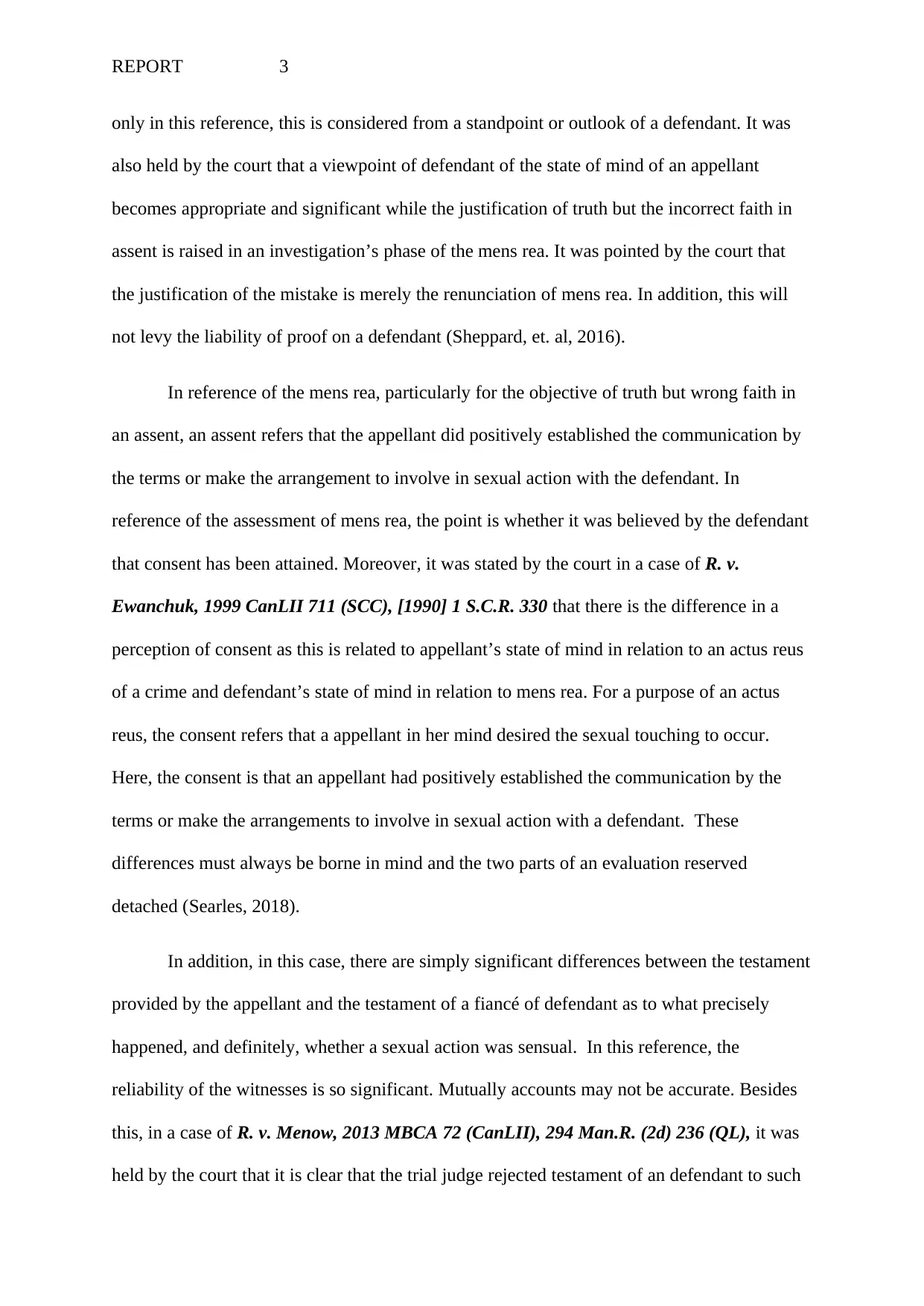
REPORT 3
only in this reference, this is considered from a standpoint or outlook of a defendant. It was
also held by the court that a viewpoint of defendant of the state of mind of an appellant
becomes appropriate and significant while the justification of truth but the incorrect faith in
assent is raised in an investigation’s phase of the mens rea. It was pointed by the court that
the justification of the mistake is merely the renunciation of mens rea. In addition, this will
not levy the liability of proof on a defendant (Sheppard, et. al, 2016).
In reference of the mens rea, particularly for the objective of truth but wrong faith in
an assent, an assent refers that the appellant did positively established the communication by
the terms or make the arrangement to involve in sexual action with the defendant. In
reference of the assessment of mens rea, the point is whether it was believed by the defendant
that consent has been attained. Moreover, it was stated by the court in a case of R. v.
Ewanchuk, 1999 CanLII 711 (SCC), [1990] 1 S.C.R. 330 that there is the difference in a
perception of consent as this is related to appellant’s state of mind in relation to an actus reus
of a crime and defendant’s state of mind in relation to mens rea. For a purpose of an actus
reus, the consent refers that a appellant in her mind desired the sexual touching to occur.
Here, the consent is that an appellant had positively established the communication by the
terms or make the arrangements to involve in sexual action with a defendant. These
differences must always be borne in mind and the two parts of an evaluation reserved
detached (Searles, 2018).
In addition, in this case, there are simply significant differences between the testament
provided by the appellant and the testament of a fiancé of defendant as to what precisely
happened, and definitely, whether a sexual action was sensual. In this reference, the
reliability of the witnesses is so significant. Mutually accounts may not be accurate. Besides
this, in a case of R. v. Menow, 2013 MBCA 72 (CanLII), 294 Man.R. (2d) 236 (QL), it was
held by the court that it is clear that the trial judge rejected testament of an defendant to such
only in this reference, this is considered from a standpoint or outlook of a defendant. It was
also held by the court that a viewpoint of defendant of the state of mind of an appellant
becomes appropriate and significant while the justification of truth but the incorrect faith in
assent is raised in an investigation’s phase of the mens rea. It was pointed by the court that
the justification of the mistake is merely the renunciation of mens rea. In addition, this will
not levy the liability of proof on a defendant (Sheppard, et. al, 2016).
In reference of the mens rea, particularly for the objective of truth but wrong faith in
an assent, an assent refers that the appellant did positively established the communication by
the terms or make the arrangement to involve in sexual action with the defendant. In
reference of the assessment of mens rea, the point is whether it was believed by the defendant
that consent has been attained. Moreover, it was stated by the court in a case of R. v.
Ewanchuk, 1999 CanLII 711 (SCC), [1990] 1 S.C.R. 330 that there is the difference in a
perception of consent as this is related to appellant’s state of mind in relation to an actus reus
of a crime and defendant’s state of mind in relation to mens rea. For a purpose of an actus
reus, the consent refers that a appellant in her mind desired the sexual touching to occur.
Here, the consent is that an appellant had positively established the communication by the
terms or make the arrangements to involve in sexual action with a defendant. These
differences must always be borne in mind and the two parts of an evaluation reserved
detached (Searles, 2018).
In addition, in this case, there are simply significant differences between the testament
provided by the appellant and the testament of a fiancé of defendant as to what precisely
happened, and definitely, whether a sexual action was sensual. In this reference, the
reliability of the witnesses is so significant. Mutually accounts may not be accurate. Besides
this, in a case of R. v. Menow, 2013 MBCA 72 (CanLII), 294 Man.R. (2d) 236 (QL), it was
held by the court that it is clear that the trial judge rejected testament of an defendant to such
Paraphrase This Document
Need a fresh take? Get an instant paraphrase of this document with our AI Paraphraser
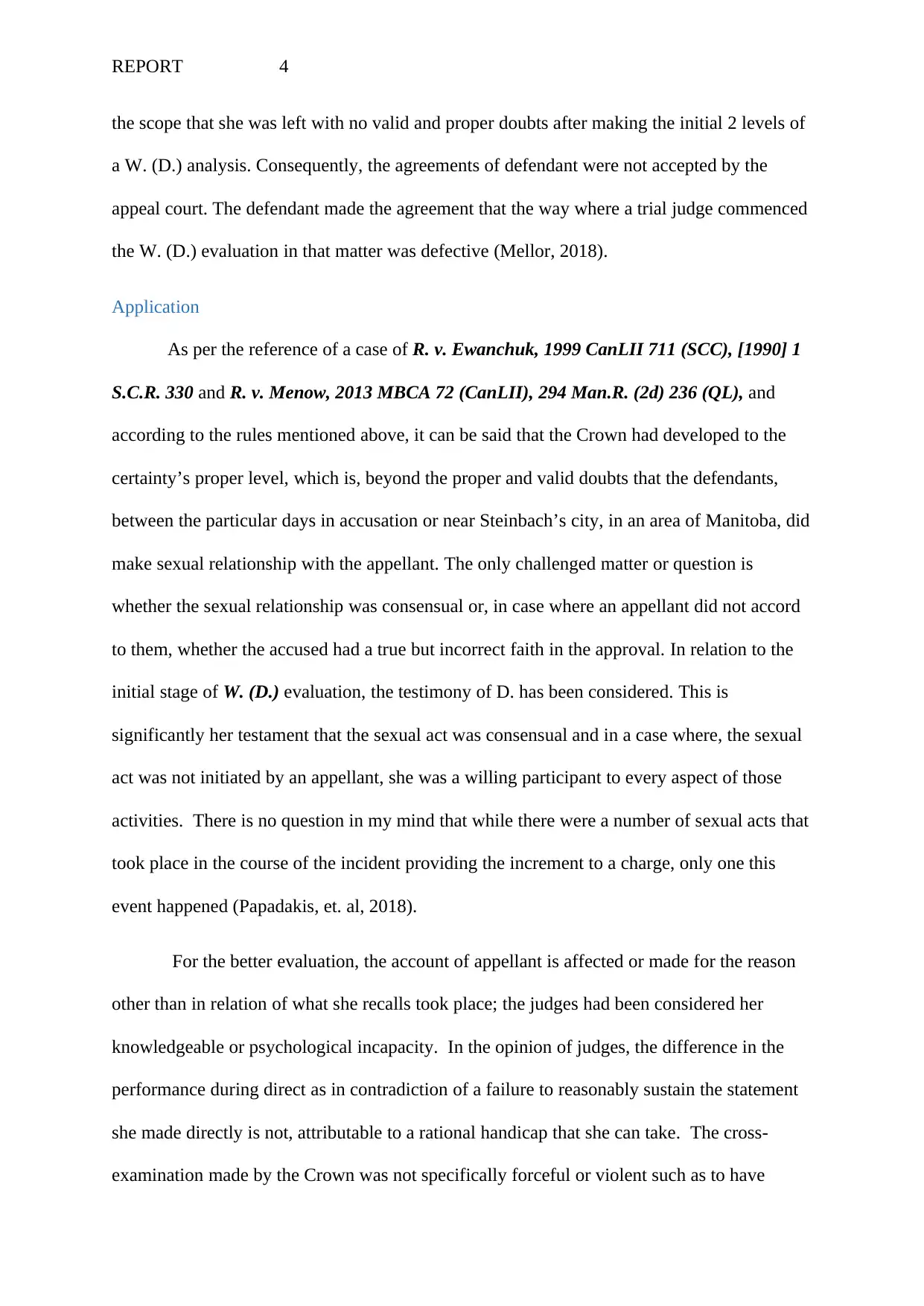
REPORT 4
the scope that she was left with no valid and proper doubts after making the initial 2 levels of
a W. (D.) analysis. Consequently, the agreements of defendant were not accepted by the
appeal court. The defendant made the agreement that the way where a trial judge commenced
the W. (D.) evaluation in that matter was defective (Mellor, 2018).
Application
As per the reference of a case of R. v. Ewanchuk, 1999 CanLII 711 (SCC), [1990] 1
S.C.R. 330 and R. v. Menow, 2013 MBCA 72 (CanLII), 294 Man.R. (2d) 236 (QL), and
according to the rules mentioned above, it can be said that the Crown had developed to the
certainty’s proper level, which is, beyond the proper and valid doubts that the defendants,
between the particular days in accusation or near Steinbach’s city, in an area of Manitoba, did
make sexual relationship with the appellant. The only challenged matter or question is
whether the sexual relationship was consensual or, in case where an appellant did not accord
to them, whether the accused had a true but incorrect faith in the approval. In relation to the
initial stage of W. (D.) evaluation, the testimony of D. has been considered. This is
significantly her testament that the sexual act was consensual and in a case where, the sexual
act was not initiated by an appellant, she was a willing participant to every aspect of those
activities. There is no question in my mind that while there were a number of sexual acts that
took place in the course of the incident providing the increment to a charge, only one this
event happened (Papadakis, et. al, 2018).
For the better evaluation, the account of appellant is affected or made for the reason
other than in relation of what she recalls took place; the judges had been considered her
knowledgeable or psychological incapacity. In the opinion of judges, the difference in the
performance during direct as in contradiction of a failure to reasonably sustain the statement
she made directly is not, attributable to a rational handicap that she can take. The cross-
examination made by the Crown was not specifically forceful or violent such as to have
the scope that she was left with no valid and proper doubts after making the initial 2 levels of
a W. (D.) analysis. Consequently, the agreements of defendant were not accepted by the
appeal court. The defendant made the agreement that the way where a trial judge commenced
the W. (D.) evaluation in that matter was defective (Mellor, 2018).
Application
As per the reference of a case of R. v. Ewanchuk, 1999 CanLII 711 (SCC), [1990] 1
S.C.R. 330 and R. v. Menow, 2013 MBCA 72 (CanLII), 294 Man.R. (2d) 236 (QL), and
according to the rules mentioned above, it can be said that the Crown had developed to the
certainty’s proper level, which is, beyond the proper and valid doubts that the defendants,
between the particular days in accusation or near Steinbach’s city, in an area of Manitoba, did
make sexual relationship with the appellant. The only challenged matter or question is
whether the sexual relationship was consensual or, in case where an appellant did not accord
to them, whether the accused had a true but incorrect faith in the approval. In relation to the
initial stage of W. (D.) evaluation, the testimony of D. has been considered. This is
significantly her testament that the sexual act was consensual and in a case where, the sexual
act was not initiated by an appellant, she was a willing participant to every aspect of those
activities. There is no question in my mind that while there were a number of sexual acts that
took place in the course of the incident providing the increment to a charge, only one this
event happened (Papadakis, et. al, 2018).
For the better evaluation, the account of appellant is affected or made for the reason
other than in relation of what she recalls took place; the judges had been considered her
knowledgeable or psychological incapacity. In the opinion of judges, the difference in the
performance during direct as in contradiction of a failure to reasonably sustain the statement
she made directly is not, attributable to a rational handicap that she can take. The cross-
examination made by the Crown was not specifically forceful or violent such as to have
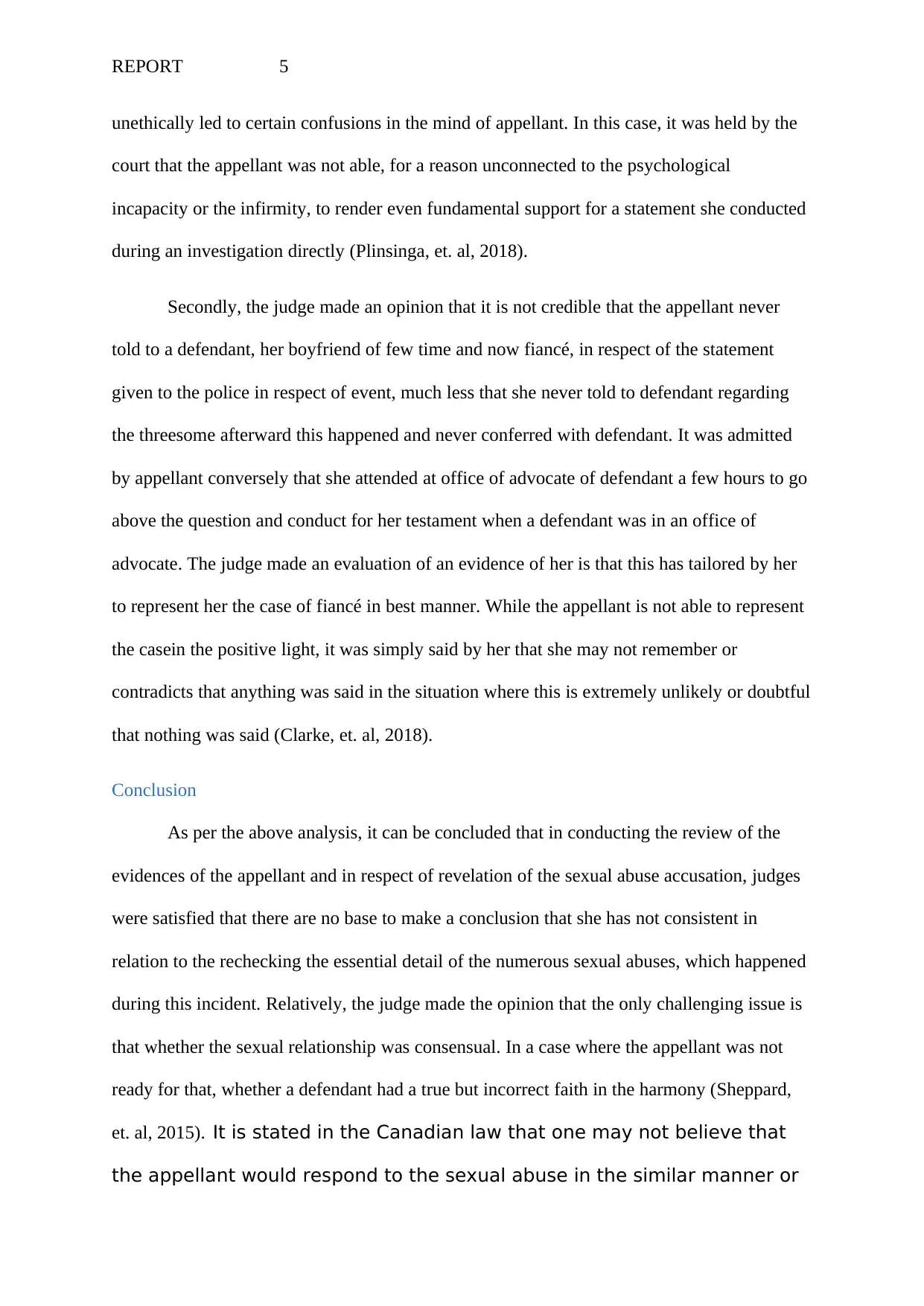
REPORT 5
unethically led to certain confusions in the mind of appellant. In this case, it was held by the
court that the appellant was not able, for a reason unconnected to the psychological
incapacity or the infirmity, to render even fundamental support for a statement she conducted
during an investigation directly (Plinsinga, et. al, 2018).
Secondly, the judge made an opinion that it is not credible that the appellant never
told to a defendant, her boyfriend of few time and now fiancé, in respect of the statement
given to the police in respect of event, much less that she never told to defendant regarding
the threesome afterward this happened and never conferred with defendant. It was admitted
by appellant conversely that she attended at office of advocate of defendant a few hours to go
above the question and conduct for her testament when a defendant was in an office of
advocate. The judge made an evaluation of an evidence of her is that this has tailored by her
to represent her the case of fiancé in best manner. While the appellant is not able to represent
the casein the positive light, it was simply said by her that she may not remember or
contradicts that anything was said in the situation where this is extremely unlikely or doubtful
that nothing was said (Clarke, et. al, 2018).
Conclusion
As per the above analysis, it can be concluded that in conducting the review of the
evidences of the appellant and in respect of revelation of the sexual abuse accusation, judges
were satisfied that there are no base to make a conclusion that she has not consistent in
relation to the rechecking the essential detail of the numerous sexual abuses, which happened
during this incident. Relatively, the judge made the opinion that the only challenging issue is
that whether the sexual relationship was consensual. In a case where the appellant was not
ready for that, whether a defendant had a true but incorrect faith in the harmony (Sheppard,
et. al, 2015). It is stated in the Canadian law that one may not believe that
the appellant would respond to the sexual abuse in the similar manner or
unethically led to certain confusions in the mind of appellant. In this case, it was held by the
court that the appellant was not able, for a reason unconnected to the psychological
incapacity or the infirmity, to render even fundamental support for a statement she conducted
during an investigation directly (Plinsinga, et. al, 2018).
Secondly, the judge made an opinion that it is not credible that the appellant never
told to a defendant, her boyfriend of few time and now fiancé, in respect of the statement
given to the police in respect of event, much less that she never told to defendant regarding
the threesome afterward this happened and never conferred with defendant. It was admitted
by appellant conversely that she attended at office of advocate of defendant a few hours to go
above the question and conduct for her testament when a defendant was in an office of
advocate. The judge made an evaluation of an evidence of her is that this has tailored by her
to represent her the case of fiancé in best manner. While the appellant is not able to represent
the casein the positive light, it was simply said by her that she may not remember or
contradicts that anything was said in the situation where this is extremely unlikely or doubtful
that nothing was said (Clarke, et. al, 2018).
Conclusion
As per the above analysis, it can be concluded that in conducting the review of the
evidences of the appellant and in respect of revelation of the sexual abuse accusation, judges
were satisfied that there are no base to make a conclusion that she has not consistent in
relation to the rechecking the essential detail of the numerous sexual abuses, which happened
during this incident. Relatively, the judge made the opinion that the only challenging issue is
that whether the sexual relationship was consensual. In a case where the appellant was not
ready for that, whether a defendant had a true but incorrect faith in the harmony (Sheppard,
et. al, 2015). It is stated in the Canadian law that one may not believe that
the appellant would respond to the sexual abuse in the similar manner or
⊘ This is a preview!⊘
Do you want full access?
Subscribe today to unlock all pages.

Trusted by 1+ million students worldwide
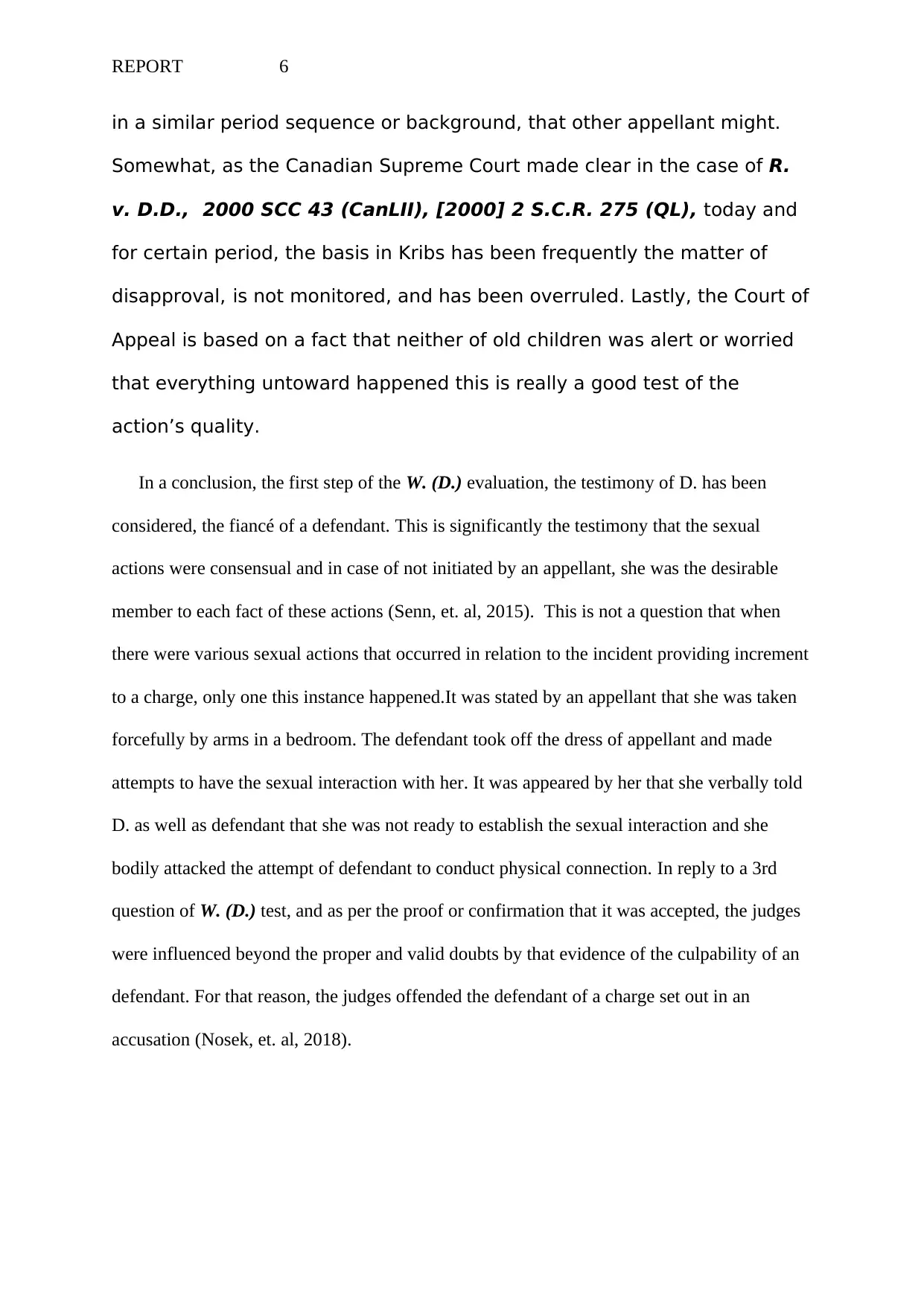
REPORT 6
in a similar period sequence or background, that other appellant might.
Somewhat, as the Canadian Supreme Court made clear in the case of R.
v. D.D., 2000 SCC 43 (CanLII), [2000] 2 S.C.R. 275 (QL), today and
for certain period, the basis in Kribs has been frequently the matter of
disapproval, is not monitored, and has been overruled. Lastly, the Court of
Appeal is based on a fact that neither of old children was alert or worried
that everything untoward happened this is really a good test of the
action’s quality.
In a conclusion, the first step of the W. (D.) evaluation, the testimony of D. has been
considered, the fiancé of a defendant. This is significantly the testimony that the sexual
actions were consensual and in case of not initiated by an appellant, she was the desirable
member to each fact of these actions (Senn, et. al, 2015). This is not a question that when
there were various sexual actions that occurred in relation to the incident providing increment
to a charge, only one this instance happened.It was stated by an appellant that she was taken
forcefully by arms in a bedroom. The defendant took off the dress of appellant and made
attempts to have the sexual interaction with her. It was appeared by her that she verbally told
D. as well as defendant that she was not ready to establish the sexual interaction and she
bodily attacked the attempt of defendant to conduct physical connection. In reply to a 3rd
question of W. (D.) test, and as per the proof or confirmation that it was accepted, the judges
were influenced beyond the proper and valid doubts by that evidence of the culpability of an
defendant. For that reason, the judges offended the defendant of a charge set out in an
accusation (Nosek, et. al, 2018).
in a similar period sequence or background, that other appellant might.
Somewhat, as the Canadian Supreme Court made clear in the case of R.
v. D.D., 2000 SCC 43 (CanLII), [2000] 2 S.C.R. 275 (QL), today and
for certain period, the basis in Kribs has been frequently the matter of
disapproval, is not monitored, and has been overruled. Lastly, the Court of
Appeal is based on a fact that neither of old children was alert or worried
that everything untoward happened this is really a good test of the
action’s quality.
In a conclusion, the first step of the W. (D.) evaluation, the testimony of D. has been
considered, the fiancé of a defendant. This is significantly the testimony that the sexual
actions were consensual and in case of not initiated by an appellant, she was the desirable
member to each fact of these actions (Senn, et. al, 2015). This is not a question that when
there were various sexual actions that occurred in relation to the incident providing increment
to a charge, only one this instance happened.It was stated by an appellant that she was taken
forcefully by arms in a bedroom. The defendant took off the dress of appellant and made
attempts to have the sexual interaction with her. It was appeared by her that she verbally told
D. as well as defendant that she was not ready to establish the sexual interaction and she
bodily attacked the attempt of defendant to conduct physical connection. In reply to a 3rd
question of W. (D.) test, and as per the proof or confirmation that it was accepted, the judges
were influenced beyond the proper and valid doubts by that evidence of the culpability of an
defendant. For that reason, the judges offended the defendant of a charge set out in an
accusation (Nosek, et. al, 2018).
Paraphrase This Document
Need a fresh take? Get an instant paraphrase of this document with our AI Paraphraser
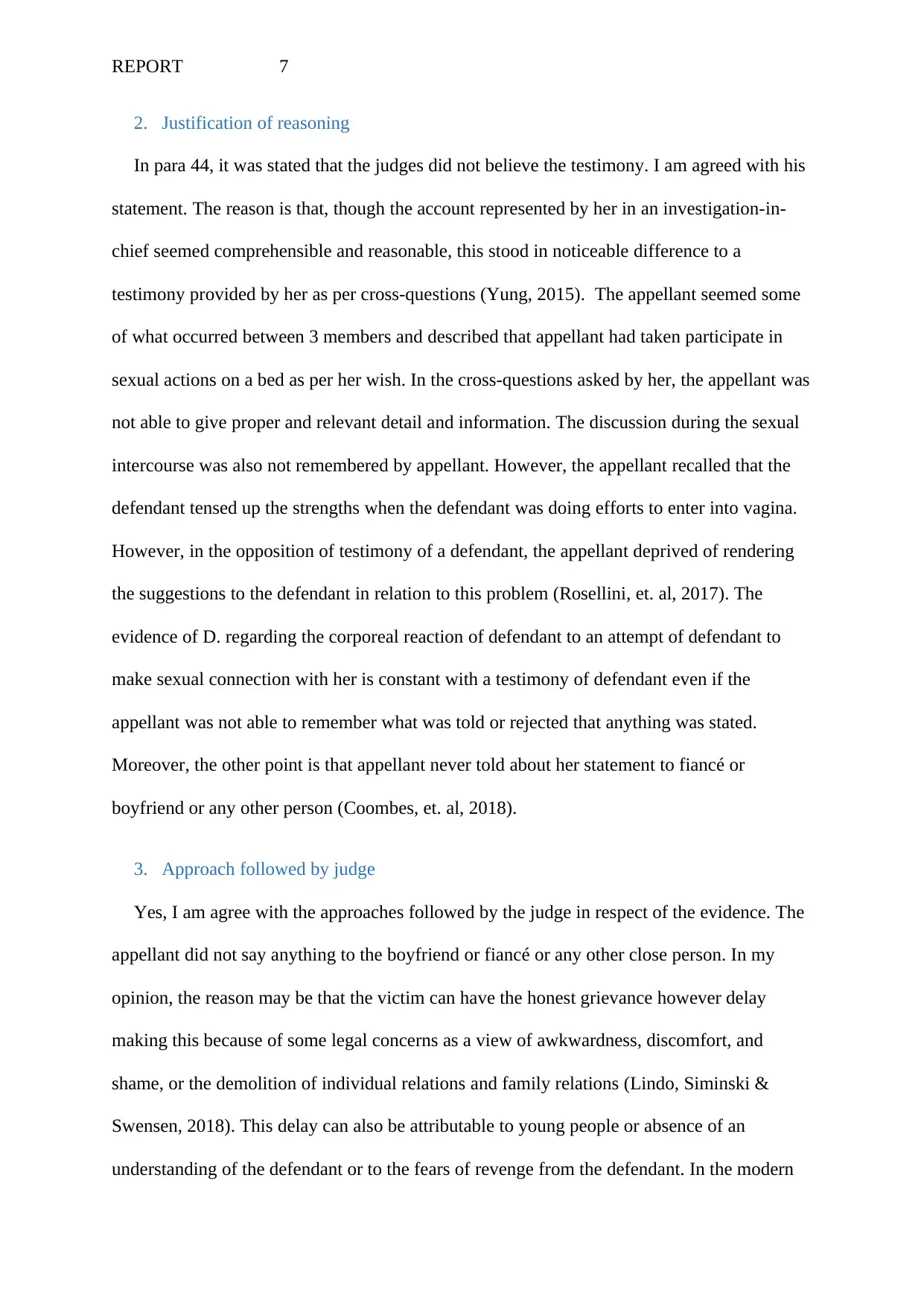
REPORT 7
2. Justification of reasoning
In para 44, it was stated that the judges did not believe the testimony. I am agreed with his
statement. The reason is that, though the account represented by her in an investigation-in-
chief seemed comprehensible and reasonable, this stood in noticeable difference to a
testimony provided by her as per cross-questions (Yung, 2015). The appellant seemed some
of what occurred between 3 members and described that appellant had taken participate in
sexual actions on a bed as per her wish. In the cross-questions asked by her, the appellant was
not able to give proper and relevant detail and information. The discussion during the sexual
intercourse was also not remembered by appellant. However, the appellant recalled that the
defendant tensed up the strengths when the defendant was doing efforts to enter into vagina.
However, in the opposition of testimony of a defendant, the appellant deprived of rendering
the suggestions to the defendant in relation to this problem (Rosellini, et. al, 2017). The
evidence of D. regarding the corporeal reaction of defendant to an attempt of defendant to
make sexual connection with her is constant with a testimony of defendant even if the
appellant was not able to remember what was told or rejected that anything was stated.
Moreover, the other point is that appellant never told about her statement to fiancé or
boyfriend or any other person (Coombes, et. al, 2018).
3. Approach followed by judge
Yes, I am agree with the approaches followed by the judge in respect of the evidence. The
appellant did not say anything to the boyfriend or fiancé or any other close person. In my
opinion, the reason may be that the victim can have the honest grievance however delay
making this because of some legal concerns as a view of awkwardness, discomfort, and
shame, or the demolition of individual relations and family relations (Lindo, Siminski &
Swensen, 2018). This delay can also be attributable to young people or absence of an
understanding of the defendant or to the fears of revenge from the defendant. In the modern
2. Justification of reasoning
In para 44, it was stated that the judges did not believe the testimony. I am agreed with his
statement. The reason is that, though the account represented by her in an investigation-in-
chief seemed comprehensible and reasonable, this stood in noticeable difference to a
testimony provided by her as per cross-questions (Yung, 2015). The appellant seemed some
of what occurred between 3 members and described that appellant had taken participate in
sexual actions on a bed as per her wish. In the cross-questions asked by her, the appellant was
not able to give proper and relevant detail and information. The discussion during the sexual
intercourse was also not remembered by appellant. However, the appellant recalled that the
defendant tensed up the strengths when the defendant was doing efforts to enter into vagina.
However, in the opposition of testimony of a defendant, the appellant deprived of rendering
the suggestions to the defendant in relation to this problem (Rosellini, et. al, 2017). The
evidence of D. regarding the corporeal reaction of defendant to an attempt of defendant to
make sexual connection with her is constant with a testimony of defendant even if the
appellant was not able to remember what was told or rejected that anything was stated.
Moreover, the other point is that appellant never told about her statement to fiancé or
boyfriend or any other person (Coombes, et. al, 2018).
3. Approach followed by judge
Yes, I am agree with the approaches followed by the judge in respect of the evidence. The
appellant did not say anything to the boyfriend or fiancé or any other close person. In my
opinion, the reason may be that the victim can have the honest grievance however delay
making this because of some legal concerns as a view of awkwardness, discomfort, and
shame, or the demolition of individual relations and family relations (Lindo, Siminski &
Swensen, 2018). This delay can also be attributable to young people or absence of an
understanding of the defendant or to the fears of revenge from the defendant. In the modern

REPORT 8
societies, there is no longer the practical links between the authenticity of the grievance and a
punctuality with that this is created (Rosellini, et. al, 2017). There is a possibility that because
of the fear and image, she did not tell anyone her statement given to police. The expectation
of medieval England as to reactions of the blameless or guiltless victim of the sexual assault
is no longer applicable (Hermanstyne, et. al, 2017).
societies, there is no longer the practical links between the authenticity of the grievance and a
punctuality with that this is created (Rosellini, et. al, 2017). There is a possibility that because
of the fear and image, she did not tell anyone her statement given to police. The expectation
of medieval England as to reactions of the blameless or guiltless victim of the sexual assault
is no longer applicable (Hermanstyne, et. al, 2017).
⊘ This is a preview!⊘
Do you want full access?
Subscribe today to unlock all pages.

Trusted by 1+ million students worldwide
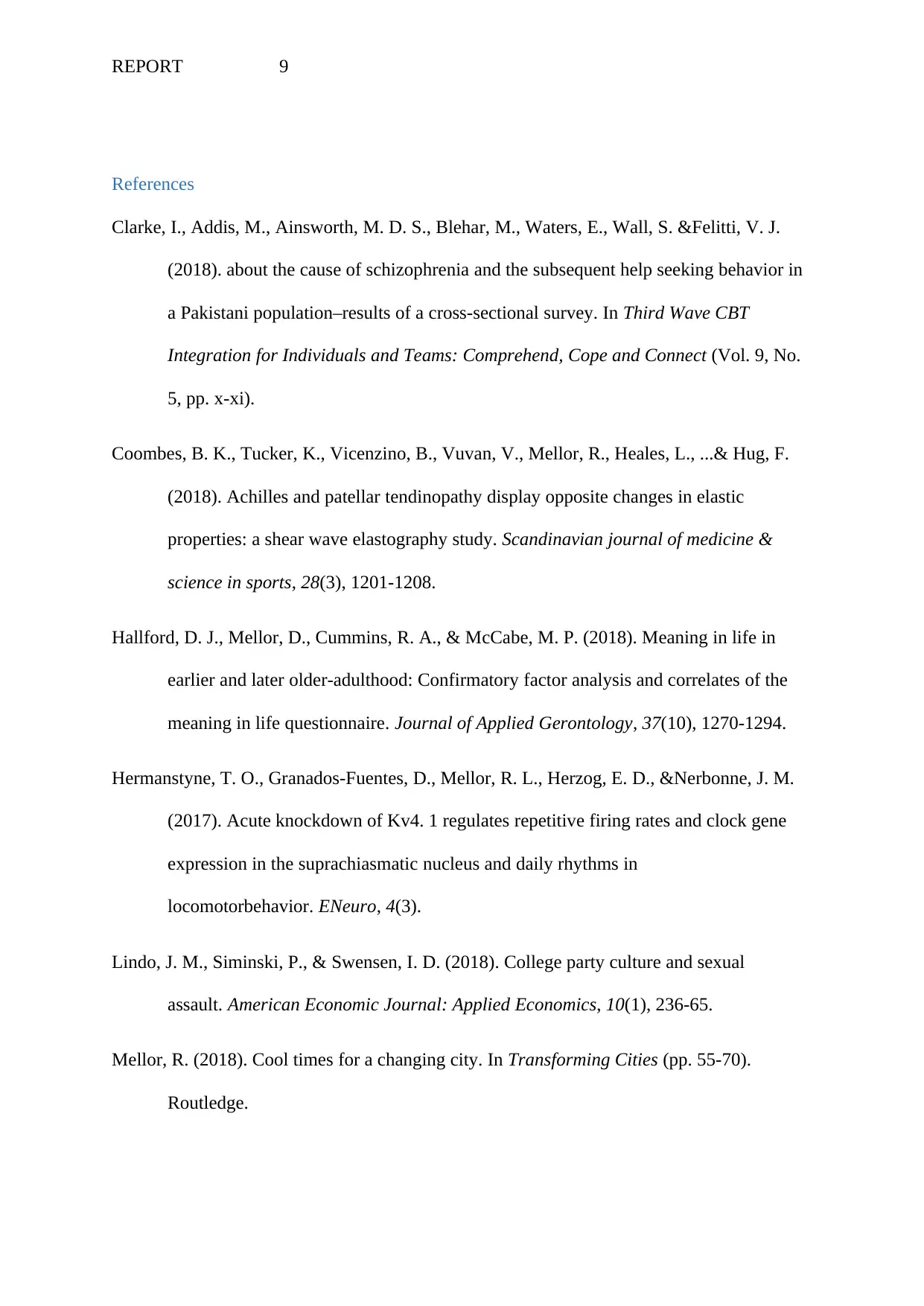
REPORT 9
References
Clarke, I., Addis, M., Ainsworth, M. D. S., Blehar, M., Waters, E., Wall, S. &Felitti, V. J.
(2018). about the cause of schizophrenia and the subsequent help seeking behavior in
a Pakistani population–results of a cross-sectional survey. In Third Wave CBT
Integration for Individuals and Teams: Comprehend, Cope and Connect (Vol. 9, No.
5, pp. x-xi).
Coombes, B. K., Tucker, K., Vicenzino, B., Vuvan, V., Mellor, R., Heales, L., ...& Hug, F.
(2018). Achilles and patellar tendinopathy display opposite changes in elastic
properties: a shear wave elastography study. Scandinavian journal of medicine &
science in sports, 28(3), 1201-1208.
Hallford, D. J., Mellor, D., Cummins, R. A., & McCabe, M. P. (2018). Meaning in life in
earlier and later older-adulthood: Confirmatory factor analysis and correlates of the
meaning in life questionnaire. Journal of Applied Gerontology, 37(10), 1270-1294.
Hermanstyne, T. O., Granados-Fuentes, D., Mellor, R. L., Herzog, E. D., &Nerbonne, J. M.
(2017). Acute knockdown of Kv4. 1 regulates repetitive firing rates and clock gene
expression in the suprachiasmatic nucleus and daily rhythms in
locomotorbehavior. ENeuro, 4(3).
Lindo, J. M., Siminski, P., & Swensen, I. D. (2018). College party culture and sexual
assault. American Economic Journal: Applied Economics, 10(1), 236-65.
Mellor, R. (2018). Cool times for a changing city. In Transforming Cities (pp. 55-70).
Routledge.
References
Clarke, I., Addis, M., Ainsworth, M. D. S., Blehar, M., Waters, E., Wall, S. &Felitti, V. J.
(2018). about the cause of schizophrenia and the subsequent help seeking behavior in
a Pakistani population–results of a cross-sectional survey. In Third Wave CBT
Integration for Individuals and Teams: Comprehend, Cope and Connect (Vol. 9, No.
5, pp. x-xi).
Coombes, B. K., Tucker, K., Vicenzino, B., Vuvan, V., Mellor, R., Heales, L., ...& Hug, F.
(2018). Achilles and patellar tendinopathy display opposite changes in elastic
properties: a shear wave elastography study. Scandinavian journal of medicine &
science in sports, 28(3), 1201-1208.
Hallford, D. J., Mellor, D., Cummins, R. A., & McCabe, M. P. (2018). Meaning in life in
earlier and later older-adulthood: Confirmatory factor analysis and correlates of the
meaning in life questionnaire. Journal of Applied Gerontology, 37(10), 1270-1294.
Hermanstyne, T. O., Granados-Fuentes, D., Mellor, R. L., Herzog, E. D., &Nerbonne, J. M.
(2017). Acute knockdown of Kv4. 1 regulates repetitive firing rates and clock gene
expression in the suprachiasmatic nucleus and daily rhythms in
locomotorbehavior. ENeuro, 4(3).
Lindo, J. M., Siminski, P., & Swensen, I. D. (2018). College party culture and sexual
assault. American Economic Journal: Applied Economics, 10(1), 236-65.
Mellor, R. (2018). Cool times for a changing city. In Transforming Cities (pp. 55-70).
Routledge.
Paraphrase This Document
Need a fresh take? Get an instant paraphrase of this document with our AI Paraphraser
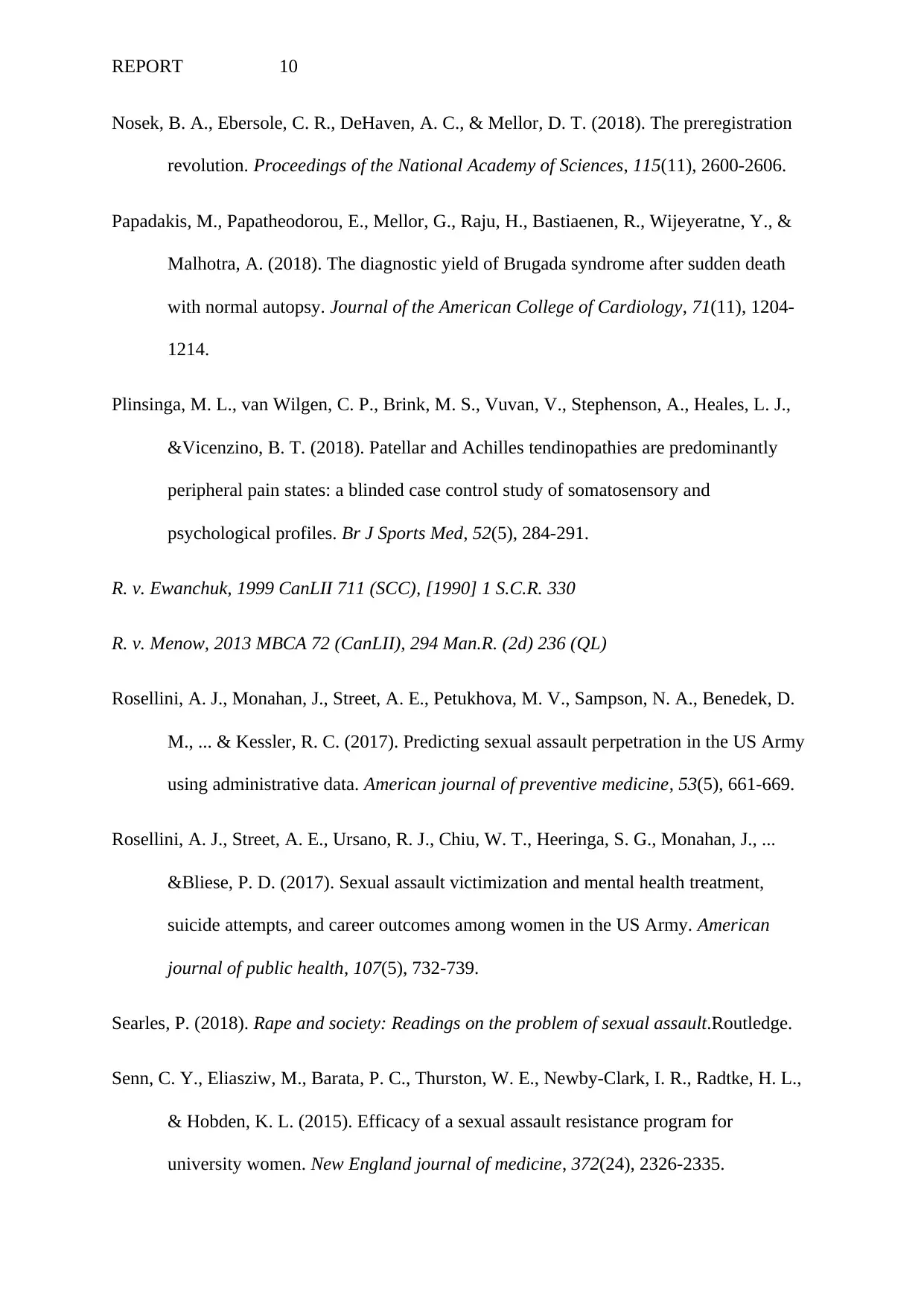
REPORT 10
Nosek, B. A., Ebersole, C. R., DeHaven, A. C., & Mellor, D. T. (2018). The preregistration
revolution. Proceedings of the National Academy of Sciences, 115(11), 2600-2606.
Papadakis, M., Papatheodorou, E., Mellor, G., Raju, H., Bastiaenen, R., Wijeyeratne, Y., &
Malhotra, A. (2018). The diagnostic yield of Brugada syndrome after sudden death
with normal autopsy. Journal of the American College of Cardiology, 71(11), 1204-
1214.
Plinsinga, M. L., van Wilgen, C. P., Brink, M. S., Vuvan, V., Stephenson, A., Heales, L. J.,
&Vicenzino, B. T. (2018). Patellar and Achilles tendinopathies are predominantly
peripheral pain states: a blinded case control study of somatosensory and
psychological profiles. Br J Sports Med, 52(5), 284-291.
R. v. Ewanchuk, 1999 CanLII 711 (SCC), [1990] 1 S.C.R. 330
R. v. Menow, 2013 MBCA 72 (CanLII), 294 Man.R. (2d) 236 (QL)
Rosellini, A. J., Monahan, J., Street, A. E., Petukhova, M. V., Sampson, N. A., Benedek, D.
M., ... & Kessler, R. C. (2017). Predicting sexual assault perpetration in the US Army
using administrative data. American journal of preventive medicine, 53(5), 661-669.
Rosellini, A. J., Street, A. E., Ursano, R. J., Chiu, W. T., Heeringa, S. G., Monahan, J., ...
&Bliese, P. D. (2017). Sexual assault victimization and mental health treatment,
suicide attempts, and career outcomes among women in the US Army. American
journal of public health, 107(5), 732-739.
Searles, P. (2018). Rape and society: Readings on the problem of sexual assault.Routledge.
Senn, C. Y., Eliasziw, M., Barata, P. C., Thurston, W. E., Newby-Clark, I. R., Radtke, H. L.,
& Hobden, K. L. (2015). Efficacy of a sexual assault resistance program for
university women. New England journal of medicine, 372(24), 2326-2335.
Nosek, B. A., Ebersole, C. R., DeHaven, A. C., & Mellor, D. T. (2018). The preregistration
revolution. Proceedings of the National Academy of Sciences, 115(11), 2600-2606.
Papadakis, M., Papatheodorou, E., Mellor, G., Raju, H., Bastiaenen, R., Wijeyeratne, Y., &
Malhotra, A. (2018). The diagnostic yield of Brugada syndrome after sudden death
with normal autopsy. Journal of the American College of Cardiology, 71(11), 1204-
1214.
Plinsinga, M. L., van Wilgen, C. P., Brink, M. S., Vuvan, V., Stephenson, A., Heales, L. J.,
&Vicenzino, B. T. (2018). Patellar and Achilles tendinopathies are predominantly
peripheral pain states: a blinded case control study of somatosensory and
psychological profiles. Br J Sports Med, 52(5), 284-291.
R. v. Ewanchuk, 1999 CanLII 711 (SCC), [1990] 1 S.C.R. 330
R. v. Menow, 2013 MBCA 72 (CanLII), 294 Man.R. (2d) 236 (QL)
Rosellini, A. J., Monahan, J., Street, A. E., Petukhova, M. V., Sampson, N. A., Benedek, D.
M., ... & Kessler, R. C. (2017). Predicting sexual assault perpetration in the US Army
using administrative data. American journal of preventive medicine, 53(5), 661-669.
Rosellini, A. J., Street, A. E., Ursano, R. J., Chiu, W. T., Heeringa, S. G., Monahan, J., ...
&Bliese, P. D. (2017). Sexual assault victimization and mental health treatment,
suicide attempts, and career outcomes among women in the US Army. American
journal of public health, 107(5), 732-739.
Searles, P. (2018). Rape and society: Readings on the problem of sexual assault.Routledge.
Senn, C. Y., Eliasziw, M., Barata, P. C., Thurston, W. E., Newby-Clark, I. R., Radtke, H. L.,
& Hobden, K. L. (2015). Efficacy of a sexual assault resistance program for
university women. New England journal of medicine, 372(24), 2326-2335.
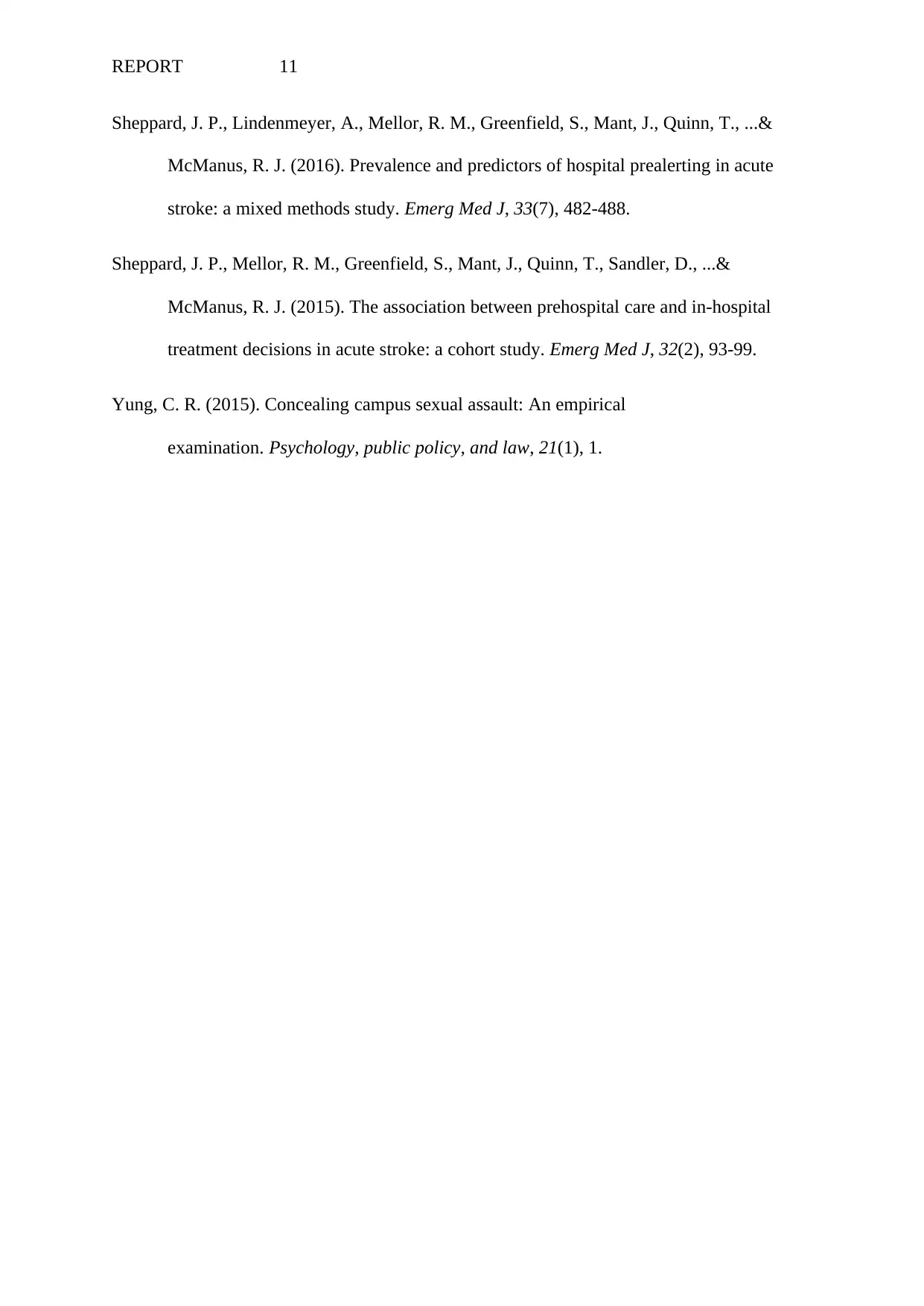
REPORT 11
Sheppard, J. P., Lindenmeyer, A., Mellor, R. M., Greenfield, S., Mant, J., Quinn, T., ...&
McManus, R. J. (2016). Prevalence and predictors of hospital prealerting in acute
stroke: a mixed methods study. Emerg Med J, 33(7), 482-488.
Sheppard, J. P., Mellor, R. M., Greenfield, S., Mant, J., Quinn, T., Sandler, D., ...&
McManus, R. J. (2015). The association between prehospital care and in-hospital
treatment decisions in acute stroke: a cohort study. Emerg Med J, 32(2), 93-99.
Yung, C. R. (2015). Concealing campus sexual assault: An empirical
examination. Psychology, public policy, and law, 21(1), 1.
Sheppard, J. P., Lindenmeyer, A., Mellor, R. M., Greenfield, S., Mant, J., Quinn, T., ...&
McManus, R. J. (2016). Prevalence and predictors of hospital prealerting in acute
stroke: a mixed methods study. Emerg Med J, 33(7), 482-488.
Sheppard, J. P., Mellor, R. M., Greenfield, S., Mant, J., Quinn, T., Sandler, D., ...&
McManus, R. J. (2015). The association between prehospital care and in-hospital
treatment decisions in acute stroke: a cohort study. Emerg Med J, 32(2), 93-99.
Yung, C. R. (2015). Concealing campus sexual assault: An empirical
examination. Psychology, public policy, and law, 21(1), 1.
⊘ This is a preview!⊘
Do you want full access?
Subscribe today to unlock all pages.

Trusted by 1+ million students worldwide
1 out of 12
Your All-in-One AI-Powered Toolkit for Academic Success.
+13062052269
info@desklib.com
Available 24*7 on WhatsApp / Email
![[object Object]](/_next/static/media/star-bottom.7253800d.svg)
Unlock your academic potential
Copyright © 2020–2025 A2Z Services. All Rights Reserved. Developed and managed by ZUCOL.